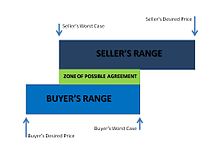This article has multiple issues. Please help improve it or discuss these issues on the talk page. (Learn how and when to remove these messages)
|
The term zone of possible agreement (ZOPA), also known as zone of potential agreement [1] or bargaining range,[2] describes the range of options available to two parties involved in sales and negotiation, where the respective minimum targets of the parties overlap. Where no such overlap is given, in other words where there is no rational agreement possibility, the inverse notion of NOPA (no possible agreement) applies. Where there is a ZOPA, an agreement within the zone is rational for both sides. Outside the zone no amount of negotiation should yield an agreement.

An understanding of the ZOPA is critical for a successful negotiation,[2] but the negotiants must first know their BATNA (best alternative to a negotiated agreement), or "walk away positions".[3] To determine whether there is a ZOPA both parties must explore each other's interests and values. This should be done early in the negotiation and be adjusted as more information is learned. Essential is also the ZOPA's size. Where a broad ZOPA is given, the parties might use strategies and tactics to influence the distribution within the ZOPA. Where the parties have a small ZOPA, the difficulty lies in finding agreeable terms.
- ^ Harvard Law School, Program on Negotiation, Deal Negotiation and Dealmaking: What to Do On Your Own, published 9 February 2015, accessed 15 April 2020
- ^ a b Spangler, Brad (June 2003). "Zone of possible agreement (ZOPA)". beyondintractability.org. Conflict Information Consortium, University of Colorado, Boulder. Retrieved 3 December 2016.
- ^ Shonk, Katie (February 2020). "How to Find the ZOPA in Business Negotiations". www.pon.harvard.edu. Program on Negotiation, Harvard Law School. Retrieved April 14, 2020.